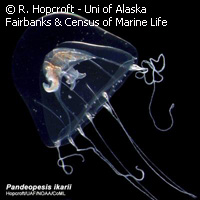Census of marine biodiversity makes a splash
Astonishing, luxuriant, complex: marine life on the blue planet, as catalogued by the scientists involved in the first global Census of Marine Life over the past 10 years, has turned out to be even more diverse than expected. Three publications and a highlight report released on 4 October 2010 complete the documentation on one of the world's largest scientific collaborations to date. Funded in part by the EU, the census was launched in 2000 in order to assess the nature, distribution and abundance of the various species that inhabit the oceans - a hugely ambitious remit that mobilised more than 2,700 scientists and 670 institutions around the world. Together, they have compiled a detailed picture of life at sea, which draws on the outcomes of more than 540 marine expeditions as well as intense research on dry land, in laboratories and archives worldwide. This planetary team of marine explorers was backed by a total investment of USD 650 million (around EUR 475 million). EU support for the census involved funding for a range of contributing projects, supported under the Sixth and Seventh Framework Programmes (FP6 and FP7). Projects implemented with financial support from the EU included ECOFUN ('Analysis of biodiversity changes on structural and functional properties of marine ecosystems under cumulative human stressors'), HERMIONE ('Hotspot ecosystem research and man's impact on European seas') and MARBEF ('Marine biodiversity and ecosystem functioning'). ECOFUN received EUR 212,125 under the FP7's Marie Curie Action 'International Outgoing Fellowships for Career Development' of the EU; HERMIONE clinched EUR 8 million under the FP7's Environment Theme; and MARBEF obtained EUR 8.71 million under the FP6's 'Sustainable development, global change and ecosystems' Thematic area. More than 2,600 academic papers, 9,000 days at sea and 6.4 million data records later, the census has provided a comprehensive update on its findings. Observations range from some of the world's smallest creatures to some of its largest, across extreme habitats and from the sea shores down into the deep abyss. 'We prevailed over early doubts that a census was possible, as well as daunting extremes of nature,' says Dr Ian Poiner, Chair of the Scientific Steering Committee of the census. 'The census enlarged the known world,' adds Dr Myriam Sibuet, Vice-Chair of the Committee. 'Life astonished us everywhere we looked. In the deep sea we found luxuriant communities despite extreme conditions. The discoveries of new species and habitats both advanced science and inspired artists with their extraordinary beauty.' The census has found more than 6,200 potentially new animals, of which 5,000 remain to be formally described. The data collected by the census is recorded in the Ocean Biogeographic Information System (OBIS), the global marine database of the census which currently draws on nearly 28 million records in total, including those directly obtained by the census. The data, which cover 120,000 species, their distribution and their migrations, point to connections among oceans, and also reveal discrepancies compared to historical descriptions of marine life - variations in abundance which are indicative of wider changes. Such changes in the world's oceans over the past centuries are largely inferred from fragmented archives. OBIS will facilitate such comparisons for future generations, as it provides a comprehensive point of reference against which they will be able to monitor further changes. This data repository features prominently within the legacy left by the census. In addition to OBIS and abundant publications and information, the census has notably produced means of identifying many marine specimens with minimal input - as little as a single fish scale - with the help of DNA (deoxyribonucleic acid) barcoding, as well as marine components of the Global Earth Observation System of Systems (GEOSS). These include contributions to a global ocean tracking network for salmon and other migrant animals, thousands of 'bio-logger' animals equipped with devices that record their diving and roaming habits, specialised sonar devices and techniques, and innovative reef monitoring structures. Advances such as these will enable marine scientists, policymakers and communities around the globe to keep a closer eye on the seas, which will play a central role in a sustainable future. 'All surface life depends on life inside and beneath the oceans,' says Dr Poiner. 'Sea life provides half of our oxygen and a lot of our food and regulates climate. We are all citizens of the sea. And while much remains unknown, including at least 750,000 undiscovered species and their roles, we are better acquainted now with our fellow travellers and their vast habitat on this globe.' 'The Age of Discovery continues,' he adds. Options for a sequel to the first census are expected to rank highly among the topics discussed in London, UK, as 300 leaders of the census community meet on 4-7 October 2010, and at the World Conference on Marine Biodiversity organised in Aberdeen, UK, in September 2011. 'The census united scientists from more than 80 nations with different talents, equipment, and interests,' remarks Dr Paul Snelgrove, who led the assembly and report of the results. 'It matched the immensity and complexity of ocean life with a human enterprise able to grasp it. The understanding and well-being of marine life may well depend on continued unity of international science.'
Countries
United Kingdom

